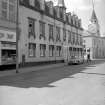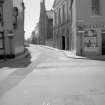Following the launch of trove.scot in February 2025 we are now planning the retiral of some of our webservices. Canmore will be switched off on 24th June 2025. Information about the closure can be found on the HES website: Retiral of HES web services | Historic Environment Scotland
Stranraer, 49 George Street, The George Hotel
Hotel (19th Century)
Site Name Stranraer, 49 George Street, The George Hotel
Classification Hotel (19th Century)
Alternative Name(s) Church Street
Canmore ID 216226
Site Number NX06SE 118
NGR NX 05970 60837
Datum OSGB36 - NGR
Permalink http://canmore.org.uk/site/216226
- Council Dumfries And Galloway
- Parish Stranraer
- Former Region Dumfries And Galloway
- Former District Wigtown
- Former County Wigtownshire
2-storey and attic, 9-bay asymmetrical-plan hotel with L plan courtyard at centre. Painted render. Base course; corniced architraved and corbelled windows at 1st floor; pedimented dormers at attic; iron hanging baskets between ground and 1st floor; dentilled cornice.
Building is dated 1876, but incorporates a late Georgian building. It was said in The Visitor's Guide to Wigtownshire by W McIlwraith (1875) that the hotel had 'capital accommodation for both man and beast.' It reflects an important aspect of late 18th century Stranraer life, as a staging post for the short crossing from Stranraer to Ireland.(Historic Scotland)
Publication Account (1995)
On the other corner of Church Street and George Street another building, the George Hotel, reflects another aspect of late eighteenth-century Stranraer life figure 20. Stranraer was a staging post for the short crossing from Scotland to Ireland. This fine coaching inn may once have been the home of the Stairs, but by the late eighteenth century it had become a hostelry for wealthy travellers. With a three-storeyed symmetrical facade, it remains an elegant building, with its stable entrance (essential in the days of horse-drawn coaches) still to be seen in Church Street. It was said in the nineteenth century by a visitor to the town that it had 'capital accommodation for both man and beast'.
Information from ‘Historic Stranraer: The Archaeological Implications of Development’ (1995).






















